Reiseablauf Baja California Desert-Explorer

Day 1 Very early in the morning we will leave Los Angeles heading South. Our 4x4s don’t particularly like the freeways. They’d rather be driven on a hot desert trail. But we’ll soon leave the paved roads behind. South of Ocotillo, a dusty little town close to the Mexican border, we’ll make a sharp right turn into the desert. Following an unmarked trail, we will cross over into Baja California. From now on it is either 4WD or on foot. We will follow one of the many tracks through Laguna Salada, a 70 mile long dry lake. Unless it’s filled with water - or mud. It is known to swallow complete trucks without a blink. Don’t worry, I know of several alternatives. Later camping in picture perfect Indian country at the feet of the Sierra de Juárez. Let’s start a nice big campfire and cook dinner together. 350 miles.
Day 2 The deceitful desert roads ahead, some of them long forgotten secret roads built by the U.S. Corps of Engineers dating back to WW II, demand every bit of our concentration. Mistakes out here in the middle of nowhere could have painful consequences. We have no better choice, however. These trails are the only access to a wonderful world of unusual plants and wildlife. Not a single soul lives out here. Parts of the trails are almost impassable. Almost. But not to worry, we not only learn how to put the obstacles successfully behind us, but also some basics of desert survival. Camp in indescribable desert solitude. Only coyotes and burrows might come visit us. 20 miles.
Day 3 & 4 And on we go following the “Pole Line Road”. A long forgotten road that follows a secret U.S. Army telephone line. Remains of World War II. A few wooden poles are still hidden in a forest of cactus. It took me many months of driving around in circles to finally re-discover it in 1986. At the same time I saw a beautiful cactus garden that has no equal in all of Baja California. I’ll show you where it is. Bring your camera! Later, another night under glittering stars awaits us. On our way to San Felipe you’ll find out how rough the race course of the famous Baja 1000 really is. You’ll get to drive on it. It’s tougher and meaner than you might have thought. When we reach the Sea of Cortez we should jump right in to wash away the dust of the previous days. Dinner at “El Nido” in San Felipe, a not-so-sleepy-anymore fishing village. The tourist Dollar is rapidly changing the small beach community Camping south of town at Playa Percebú. 55 miles.
Day 5 The Mexicans are proud to have a paved road to Puertocitos now, but tide permitting we’ll drive along the beach. After a refreshing Pacifico beer in Puertocito’s one and only cantina a washboardy dirt road following the spectacular Gulf-coast awaits us. You’ll get to put your wheels on the “Three Sisters”, an infamous part of the old “road“. It’s unbelievable what hardship travelers had to endure driving south before the present dirt road was in place. With exception of a few Ocotillos and Elephant trees the desert landscape past Puertocitos is as bare as the moon. The waters of the Sea of Cortez are of a seemingly unreal dark blue. Lunch will be either at Punta Bufeo or Alfonsina’s cantina. Time to watch a ballet of dolphins and the many squadrons of pelicans. In the late afternoon we will enter Cañon Santa Maria. There is one very narrow boulder-strewn spot which might require some “road building”. Together we will be able to accomplish this task successfully. Our camp is on a historical Indian camping site. 80 miles.
Day 6 Beach day at Bahía San Luis Gonzaga, one of the nicest bay’s in Baja California. We could do nothing all day. Stare over the water. Watch the pelicans dive for their catch of the day. See if we can spot some dolphins frolic by. Or we can throw out a line and see if we catch dinner (an other way of doing nothing). Go for a swim. Take the Jeep and explore one of the many nameless cañons. Or just day-dream, for instance that we will never ever return home. But careful, you will have me as a neighbor. In the late afternoon we will break up our camp and disappear into Cañon Santa Maria. The road into the canyon has at a certain point a narrow passage and we will have to haul some rocks and drive through it like on eggs. Camp on historical Indian camping-grounds. 20 km.
Day 7 Right after sunrise we will start our day hike to the ruins of Misión Santa Maria de Los Angeles. For the most part we go with the flow of the canyon. Climb over or slip underneath enormous size granite boulders. We will climb up a steep Indian trail, which has not been used for over 200 years. It is still in excellent shape. Right next to a small stream with delicious fresh water and surrounded by beautiful palm trees lay the ruins of the Mission. It’s the perfect spot for a lunch break. On our way back down we will climb through a narrow gorge, who’s white granite and dark green pools of water contrast dramatically. We will stay for an hour or so at the largest pool to swim and relax. Before dark we will return to base camp. Nothing beats the cold beers awaiting in our vehicle’s ice chests. We,ll spend one more night at the same spot or head for a beach camp. This hike through paradise like surroundings has a price, it is somewhat exhausting. The longest 4 miles of your life!
Day 8 Today we will follow the Camino Real, the historical road that connects the Missions. Certainly we will visi Coco, a world famous squatter. We will pass the ruins of the Misión Calamajue. A little further we will drive through a water filled cañon alive with birds in a bizarre cacti-forest. Nowhere else we will find Cirio-trees and Cardón-cacti of such enormous sizes. Our goal, the picturesque bay Bahía de Los Angeles with thousand of picturesque islands. Somewhere on the beach a hidden sleepy fishermen’s village. We will spent the night in the “Hotel” Las Hamacas. Hotel is a screaming overstatement, but the rooms are new, big and clean. And every room comes with a shower. 60 km.
Day 9 In the morning we will continue our trip to find the nicest Mission on this peninsula, Misión San Francisco de Borja Adac. Founded with an enormous amount of money of the Italian Nobel Lukrezia Borgia. A religious donation of the notorious female poisoner. Who could have thought that. Don’t forget your camera! The old garden with knobby grape-vines and big old fig-trees unfortunately has gone to seed, because nobody takes pride in it anymore. The last family who lives in the house opposite the Mission is planning to move soon. To somewhere were there is work. What we consider unbelievable romantic, self-contained in peaceful desert isolation, becomes for the Mexicans in the meantime pure harassment. No electricity, no TV, no money, not a new car to make the family jealous. On our way to the Mission we will see unusual Indian rock-paintings [or is it maybe Indian graffiti?]. We will camp in the wilderness. 80 km.
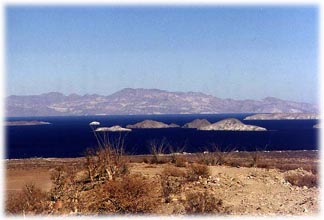
Bahia de los Angeles islands
Day 10 Drive from our last camping spot to Ensenada. Almost all the time we will be driving on paved road, the MEX 1. In Cataviña there is still a small cave-painting of the original inhabitants to be explored and a breathtaking unusual landscape of giant cacti, unreal Cirio-trees and huge granite-rocks to be admired. I hope you still have enough film left in your camera. Before we hit El Rosario’s civilization, we will drive for hours through a sparse high-desert. Up to Ensenada nothing but small settlements. At first we will see left and right tomato fields. But also we will see olive-groves and wine-estates. After approximately 500 km. we will reach Ensenada. Were we have to visit the world-famous bar “Hussong’s Cantina” at night. We will spent the night in the best hotel of Ensenada, Hotel Las Rosas.
Day 11 A last glance at the Pacific at sunrise. Finally breakfast on a white table-clothed table again, and off we go on the freeway direction Tijuana. This route is almost as nice as the stretch on Highway 1 from Big Sur to San Francisco. Tijuana is a wild exciting border city. It is chaotic, smelly and loud. On the other side everything is orderly, clean and decent. Even though everything is relative. Anyway it is a big culture shock, that will stick to you for a while. By the way, nowhere in the world there are more people crossing the border then in Tijuana. Waiting time for the border control at least one hour. Drive on highway “Interstate 5” to Los Angeles.
Ensenada - Los Angeles 5 hours. 300 km.
|
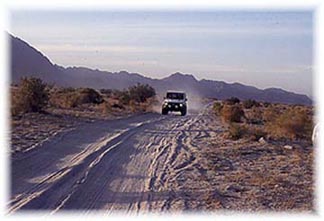 Road to San Louis Gonzaga
Road to San Louis Gonzaga
Day 5
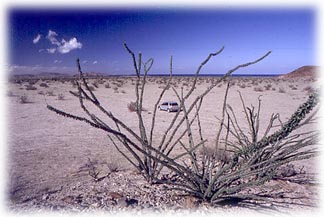
Deasert view at Gonzaga bay
Day 6
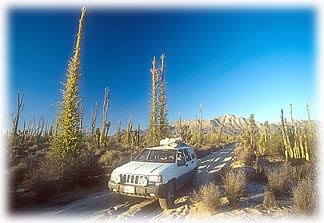
Cacti forest at Sierra la Asamblea
Day 8
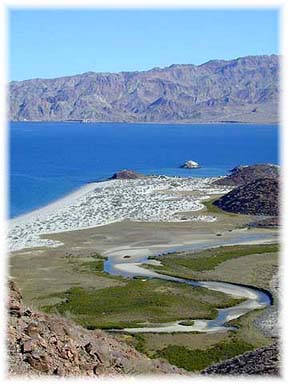
Bahia las Animas
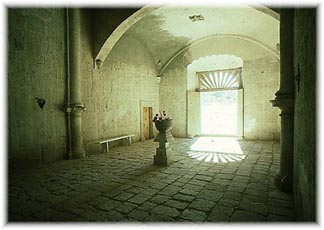
Mission San Borja

Vultures warm their feathers in the morning sun
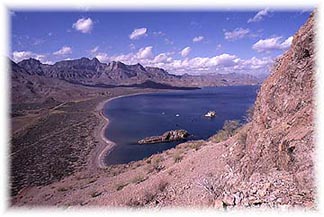
Coast line at Agua Verde
|
|